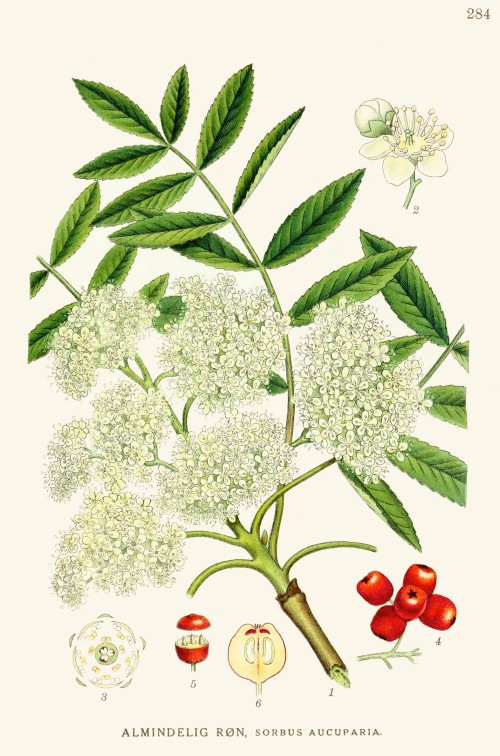Sorbus aucuparia L. - Rosaceae - (European) mountain ash, rowan, Vogelbeere, Eberesche
Deciduous tree or shrub, up to 15m high, native to Europe and northern Asia; bark smooth; leaves pinnate; corymbs of many white flowers; fruit globose, 6-10mm diam., red or orange.
„Fruit of S. aucuparia were used in the past to lure and catch birds… The fruit contain sorbitol, which can be used as a sugar substitute by diabetics, but its production is no longer relevant… Fresh fruit are usually unpalatable, but they can be debittered and made into compote, jelly, jam, a tangy syrup, a tart chutney, or juice, as well as wine and liqueur, or used for tea or to make flour.“ https://en.wikipedia.org/wiki/Sorbus_aucuparia
The berries (pulp or juice) were used in folk medicine to treat diarrhea, nephrolithiasis, and as diuretic.
[Lehrbuch der biologischen Heilmittel, Madaus, G., 1938] http://www.henriettes-herb.com/eclectic/madaus/sorbus.html
The bitter principle of S.aucuparia is mainly parasorbic acid (5,6-dihydro-6-methyl-2H-pyran-2-one), the intramolecular lactone of sorbic acid. It is converted to sorbic acid by cooking of the fruits. http://de.wikipedia.org/wiki/Vogelbeere
[Ueber das flüchtige Oel der Vogelbeeren, die Parasorbinsäure und ihre Isomerie mit der Sorbinsäure., Doebner, O., Berichte der deutschen chemischen Gesellschaft, Vol.27(1), 1894, 344-351]
„The flesh appeared to be rich in minerals (ash 10.2%), especially potassium (15.8 mg g-1), and sugars (17.7%). High values for crude proteins (25.5%) and crude fat (16.5%) were recorded in the seed, which also contained 5.5% sugars and relatively large amounts of calcium (2.9 mg g-1) and phosphorus (5.7 mg g-1)…. The berries are rich in vitamins, especially ascorbic acid (40-60 mg per 100 g berries) (Pyysalo & Kuusi 1974). They also contain several phenolic compounds, such as trans-chlorogenic, caffeic, p-coumaric and ferulic acids, cyanidin-3-galactoside (red pigment), cyanidin-3,5-diglucoside, quercetin, isoquercetin and rutin (Pyysalo & Kuusi 1974 and references therein). Although some polyphenols are known to be bitter, the bitterness of rowan berries is not owing to the polyphenols which they contain, but rather to a precursor of sorbic acid, trans-3-d-glucopyranosyloxy-5-hexanolide (Letzig 1964; Pyysalo & Kuusi 1971, 1974; see also Eder et al. 1991).“
[Sorbus aucuparia L., Raspe, O., Findlay, C., Jacquemart, A.L., Journal of Ecology, Vol.88(5), 2000, 910-930]
http://onlinelibrary.wiley.com/doi/10.1046/j.1365-2745.2000.00502.x/full
The cultivated S.aucuparia var.edulis owns non-bitter berries, with more sugar and ascorbic acid: „An edible variety, named Sorbus aucuparia var. dulcis Kraetzl, or var. edulis Dieck, or var. moravica Dippel, was first discovered in 1810 near Ostružná in the Hrubý Jeseník mountain range of Northern Moravia and became widespread in Germany and Austria the early 20th century. Its leaves are larger and pointed, only the front part of the leaflets is serrated, and they have darker bark, larger buds and larger fruit. Similar non-bitter varieties found in Southern Russia were first introduced in Central Europe in 1900 as 'Rossica' and 'Rossica Major', which has large fruit up to 1.5 cm in diameter.“
http://de.wikipedia.org/wiki/Vogelbeere
http://www.lwf.bayern.de/mam/cms04/wissenstransfer/dateien/w17_pharmazie_und_medizin_volksmedizin.pdf

Lindman, C.A.M., Bilder ur Nordens Flora, vol.2 t.284 (1922-1926)
http://plantgenera.org/species.php?id_species=961527
